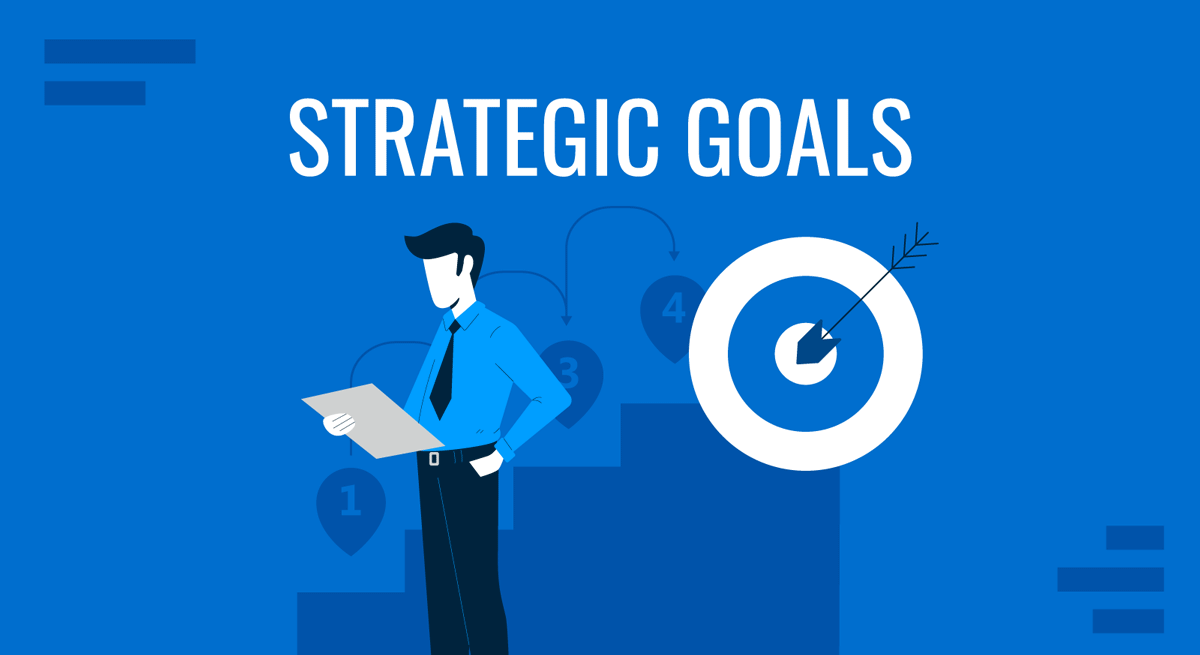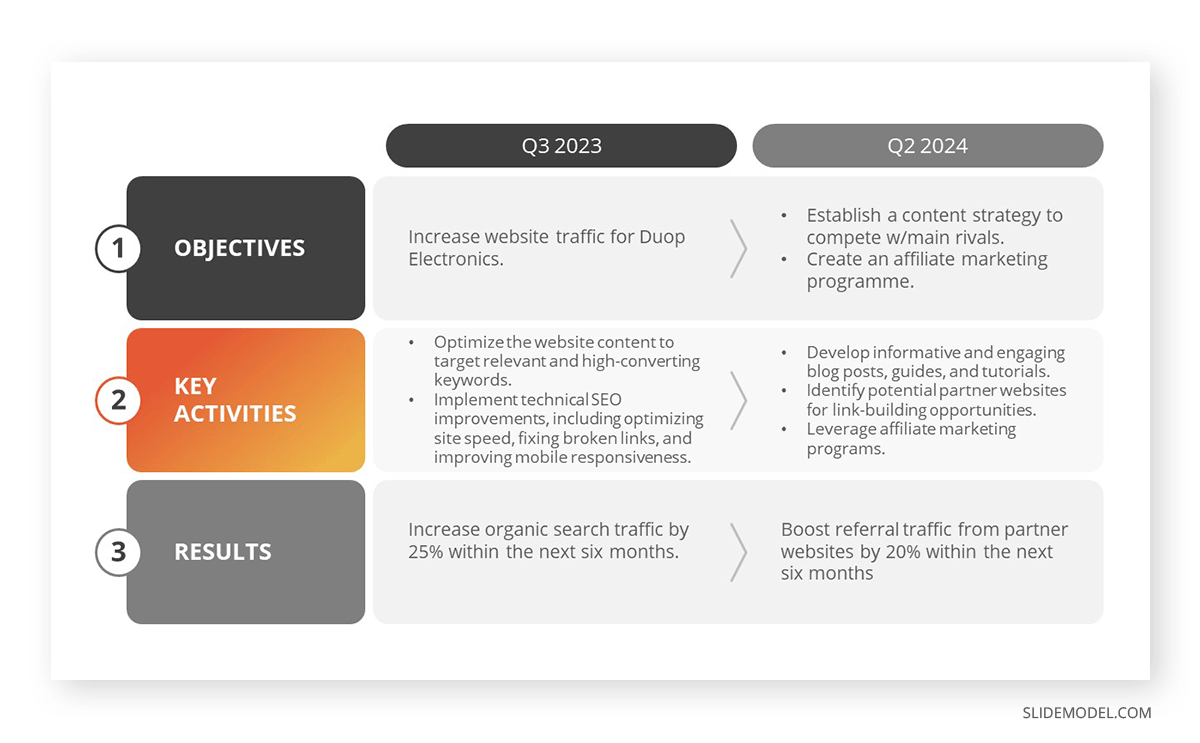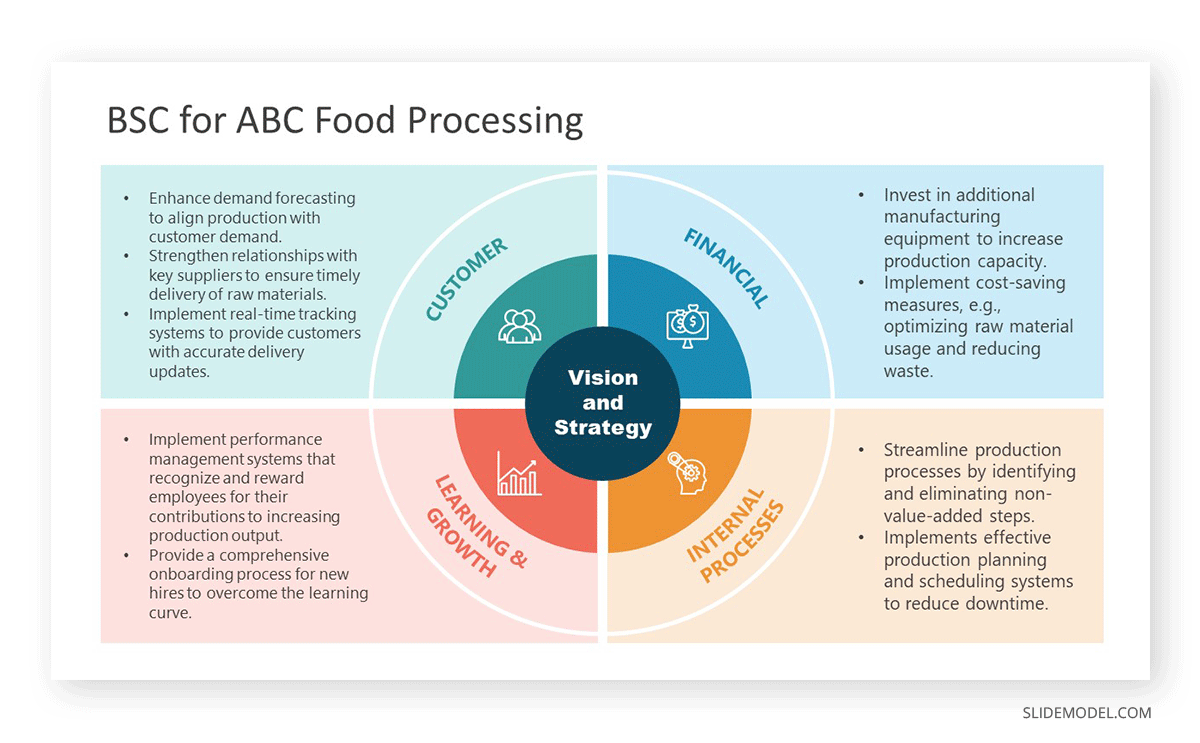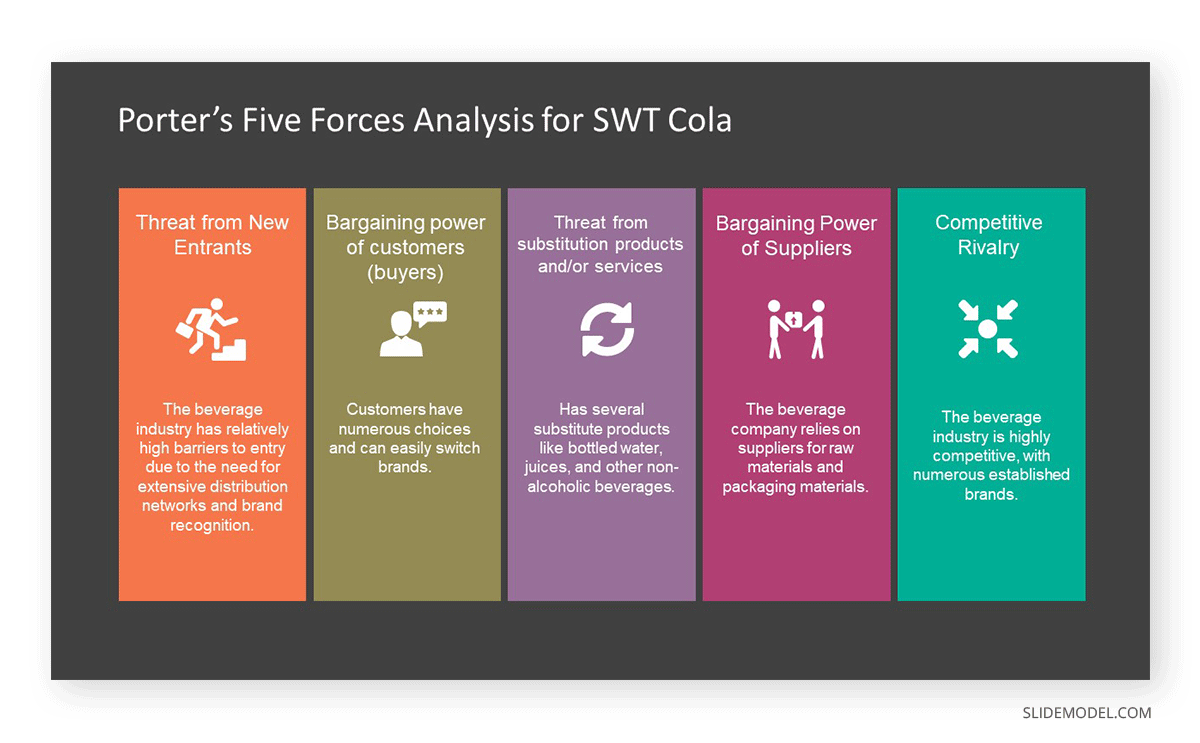
A mountain climber needs a map to navigate the treacherous terrain and, ultimately, triumph over the mountain. This scene illustrates a valuable lesson: just as a climber needs a map to guide their ascent, organizations, too, require a strategic roadmap to navigate the challenges and opportunities of the business world. Strategic goal setting serves as that map, providing a clear direction and framework for success.
In this article, we explore the significance of strategic goal setting in driving organizational success and discuss key characteristics of an effective one.
Table of Contents
- What is a Strategic Goal?
- Strategic Goal vs Strategic Plan: What’s the Difference?
- Characteristics of a Good Strategic Goal
- Strategic Goal Examples
- Goal-Setting Framework to Supplement Strategic Goals
- How to Pick the Best Tools to Showcase Strategic Goals
- How to Present Strategic Goals
- Conclusion
What is a Strategic Goal?
Strategic goals are the overarching objectives that guide an organization’s actions and decisions. These goals are typically set for a longer time horizon, ranging from three to five years or even more. Strategic goals define what an organization aspires to achieve and provide a clear focus for all stakeholders.
Articulating and presenting strategic goals to every department is crucial for companies due to several reasons:
- First and most, the strategic goal serves as a compass that aligns the efforts of each business unit towards a shared vision. It ensures that everyone understands the broader organizational objectives and how their contributions fit the larger picture.
- Well-defined strategic goals help organizations prioritize their efforts (time, money, workforce, etc.) on activities that directly contribute to achieving those goals.
- Strategic goals create a sense of ownership and accountability, empowering individuals to take ownership of their roles and responsibilities.
Before diving deeper, it’s important to distinguish strategic goals from other business goals.
While both aim to drive growth and performance, strategic goals are broader and long-term, often spanning several years and aligning closely with the company’s mission and vision.
Business goals, on the other hand, tend to be more specific, short- to mid-term objectives that support day-to-day operations and departmental outcomes. If you’re interested in understanding business goals in more detail, including examples and how they are set, you can read our article on business goals and how to create a presentation about them with one of the frameworks available for that purpose (OKR, SMART goals, BHAG, Vision & Milestone, BSC or MBO).
Strategic Goal vs Strategic Plan: What’s the Difference?
Strategic goals and strategic plans are different, although they go hand in hand.
As mentioned, strategic goals are the ultimate goal or the ideal that an organization aspires to achieve. On the other hand, a strategic plan is a document that outlines the steps that the organization needs to take to make that vision a reality.
Strategic goals and strategic planning are vital components of organizational success as they provide a sense of direction for every endeavor companies undertake.

Characteristics of a Good Strategic Goal
1. Ambitious yet Achievable
Strategic Goals should challenge organizations to strive for excellence while remaining within realistic boundaries. Jim Collins emphasized this in his book, Built to Last, using the concept of “Big, Hairy, Audacious Goals” (BHAGs). Organizations willing to bet on ambitious targets will unlock untapped potential and achieve extraordinary results. However, it is crucial to balance ambition with realism, considering the challenges that may be faced along the way, like available resources, market conditions, and competitive dynamics.
For instance, a software company might set a strategic goal of becoming the market leader in their industry within five years. While ambitious, this goal is attainable with the right resources and strategy.
2. Specific and Measurable
A strong strategic goal should be measurable, allowing for precise progress tracking and evaluation. This can be done by setting quantifiable targets or identifying key performance metrics. For instance, if the strategic goal is to improve customer satisfaction, the target could be to achieve a customer satisfaction rating of 90% within one year.
By defining specific metrics and targets, organizations gain clarity on what success looks like and can monitor their progress effectively. At the same time, it provides valuable guidance for teams to track their performance and make data-driven adjustments along the way.
3. Aligns With Company Principles
Aligning the strategic goal with the vision and mission of the organization is paramount. The strategic goal should reflect the core purpose and values of the company, reinforcing its unique identity and market positioning.
For instance, a social enterprise with a mission to promote sustainable practices might set a strategic goal of reducing its carbon footprint by a certain percentage.
4. Sets the Vision for the Future
Strategic goals are not limited to short-sighted, immediate objectives but encompass the organization’s broader vision and aspirations for the future (within a year or more). Harvard Business School Online differentiates them from operational goals, which are the smaller milestones towards the bigger goal.
For example, a strategic goal for a renewable energy company might be to transition to 100% clean energy sources within the next decade. On the other hand, their operational goal could be to increase solar energy production capacity by 20% within the next year.
Strategic Goal Examples
Using the characteristics of a good strategic goal provided, we can create a formula for creating strategic goals.

Let’s see how this formula can be applied in different industries.
Strategic Goal Examples for Marketing
- Increase brand awareness and market share by 10% in the next 12 months.
- Enhance brand loyalty and increase customer retention by 20% in the next 6 months.
- Strengthen social media presence by increasing follower engagement rate by 25% within 3 months.
- Improve website traffic by 30% within 9 months.
Strategic Goal Examples for Finances
- Increase annual revenue by 20% within the next fiscal year.
- Reduce operating expenses by 15% within the next 12 months.
- Reduce the effective tax rate by 5% within the next 2 years.
- Improve investment performance by achieving an annual return on investment (ROI) of 15% for the portfolio.
Strategic Goal Examples for Human Resources
- Increase the number of qualified candidates in the talent pipeline by 50% within the next 6 months.
- Enhance average employee competency rating by one level within the next 12 months.
- Achieve an employee engagement score of 85% and a voluntary turnover rate of less than 10% within the next 2 years.
- Achieve a diverse representation across all levels and departments within the next 3 years.
Strategic Goal Examples for Productions
- Increase production output by 20% to meet growing customer demand by the end of the year.
- Optimize production efficiency by reducing downtime by 15%.
- Reduce production costs by 10% by the end of the year.
- Improve supply chain management and reduce stockouts by 50% in the next 2 years.
Goal-Setting Framework to Supplement Strategic Goals
The broad nature of strategic goals can sometimes make it challenging for each department to fully appreciate and connect with them. Hence, companies should strive to translate their strategic goals into more specific action plans relevant to each department’s responsibilities. This helps create a clear line of sight between the strategic goals and their day-to-day work.
A goal-setting framework may help in this regard by breaking down the strategic goal into actionable operational objectives. So, what are the available goal-setting tools to utilize?
1. OKR (Objectives and Key Results)
OKR, short for objectives and key results, is a simple goal-setting template popularized by former Intel CEO Andy Grove in the ‘70s. OKRs can be written as a statement:
I will (Objective) as measured by (Key Results).
The first part of the statement (I will) represents the organization’s aspiration, typically qualitative in nature, that expresses the desired outcome. The latter part (measured by), on the other hand, outlines the quantifiable results that will provide a tangible way to assess and track the organization’s performance.
Organizations may also utilize an expanded version of the OKR template and include the key activities they must undertake to reach their goal. This will provide a more detailed roadmap of the specific actions and initiatives required from the stakeholders.
Example:
Duop Electronics is an e-commerce website specializing in electronic gadgets and accessories. Although the company has a strong online presence, they want to enhance its website traffic further to drive more visibility, increase sales, and expand its customer base.

Objective: Increase website traffic for Duop Electronics.
Key Results:
- Increase organic search traffic by 25% within the next six months.
- Boost referral traffic from partner websites by 20% within the next six months.
Activities:
- Optimize the website content to target relevant and high-converting keywords.
- Implement technical SEO improvements, including optimizing site speed, fixing broken links, and improving mobile responsiveness.
- Develop informative and engaging blog posts, guides, and tutorials.
- Identify potential partner websites for link exchanges.
- Leverage affiliate marketing programs.
2. SMART Framework
Breaking down strategic goals into SMART (specific, measurable, attainable, relevant, time-bound) goals is essential in goal-setting.
As mentioned, strategic goals are broad by nature. The SMART framework helps translate broad strategic objectives into actionable and well-defined targets. This clarity ensures that everyone involved understands what needs to be achieved and can align their efforts accordingly.
Example:
GreenLine Bank is a leading financial institution that provides a wide range of banking services to individual and business customers. Although they have a good customer retention rate of 75%, they wanted to reduce customer churn to maximize revenue. GreenLine Bank implements the SMART framework to translate its strategic goal into tangible objectives.

Specific: Increase its customer retention rate by 10% over the next year.
Measurable: Track and measure the customer churn rate monthly or quarterly using a reliable data tracking system.
Attainable: Enhance customer onboarding process, implement customer feedback mechanisms, and develop targeted retention campaigns.
Relevant: Reduced customer churn contributes to increased revenue and a positive brand reputation.
Time-bound: Achieve the target within the next 12 months by monitoring and reviewing progress regularly.
3. Balanced Scorecard
Many factors come into play toward the realization of a strategic goal, such as the financial aspect of the company and the workforce. The Balanced Scorecard (BSC) encourages companies to consider these factors to achieve a strategic goal.
BSC provides a structured framework for measuring and managing performance across different perspectives, including financial, customer, internal processes, and learning and growth. By incorporating these perspectives into the action plan, organizations can ensure the feasibility and effectiveness of the action plan.
Example:
ABC Food Processing specializes in producing packaged food products with multiple manufacturing facilities. However, the company has faced challenges in keeping up with the increasing demand due to production constraints and process inefficiencies in recent years. To stay ahead in the industry, the company wants to achieve a 20% increase in production output within 6 months to meet growing customer demand and improve profitability.
ABC Food Processing adopts the Balanced Scorecard framework to set and achieve its strategic goal.

Financial Perspective:
- Invest in additional manufacturing equipment to increase production capacity.
- Implement cost-saving measures, e.g., optimizing raw material usage and reducing waste.
Internal Processes:
- Streamline production processes by identifying and eliminating non-value-added steps.
- Implements effective production planning and scheduling systems to reduce downtime.
Learning and growth:
- Implement performance management systems that recognize and reward employees for their contributions to increasing production output.
- Provide a comprehensive onboarding process for new hires to overcome the learning curve.
Customer Perspective:
- Enhance demand forecasting to align production with customer demand.
- Strengthen relationships with key suppliers to ensure timely delivery of raw materials.
- Implement real-time tracking systems to provide customers with accurate delivery updates.
4. 30-60-90 Day Plan
The 30-60-90 Day Plan is often used during employee onboarding that outlines how the employee intends to move forward during the first 90 days on the job. It breaks goals down into 30-, 60- and 90-day increments.
While strategic goals typically encompass longer time frames, organizations can emulate this framework to set short-term objectives that contribute to achieving their overall strategic goal. It balances setting short-term objectives to maintain focus and momentum while keeping the overall strategic direction in mind.
Each period within the plan can represent an implementation phase and focus on specific actions and milestones. As each phase is completed, it sets the foundation for the subsequent phase, leading to the ultimate achievement of the strategic goal.
Example:
Blitz Tech Solutions is a software developer that specializes in custom software solutions. To expand its customer base, Blitz Tech Solutions has set a strategic goal of breaking into new markets. The company aims to establish a presence in the healthcare industry within the next year.
Instead of the 30-day increments, Blitz Tech Solutions set its milestones to 4-8-12 months.

4-Month Plan:
- Conduct comprehensive market research to identify potential target segments, competitive landscape, regulatory considerations, and decision-makers within target segments.
- Identify potential strategic partners who can help facilitate market entry.
- Assess the suitability of existing software solutions for the target segment and identify necessary modifications.
8-Month Plan
- Develop marketing strategies tailored to the target segment.
- Conduct pilot programs and collect feedback to build credibility.
- Build a network within the target segment by attending industry conferences and trade shows.
12-Month Plan
- Build a sales pipeline by engaging with potential customers identified during the previous phases.
- Provide training and resources to internal teams to equip them with the required skills when engaging with new clients in the segment.
- Review the progress of market entry efforts using key performance indicators (KPIs).
5. Porter’s Five Forces Framework
Porter’s Five Forces, a framework developed by Michael Porter, can be used to analyze the competitive dynamics of an industry and inform strategic goal-setting. While Porter’s Five Forces are typically used to assess the attractiveness of an industry or evaluate competitive advantage, they can also be employed to identify strategic goals and develop corresponding action plans.
According to this framework, five forces influence a company’s profitability and, in return, shape strategic goals. These are:
- Bargaining power of suppliers (how much power a business supplier has?)
- Bargaining power of consumers
- The threat of new entrants
- Availability of substitute products and services
- Intensity competitive rivalry
Example:
SWT Cola is a beverage company to increase its market share globally. It adopts Porter’s Five Forces framework to analyze the industry dynamics and develop an action plan.

Threats of New Entrants:
The beverage industry has relatively high barriers to entry due to the need for extensive distribution networks and brand recognition.
Solution: Secure exclusive partnerships with key distributors within the target market. Invest in brand building and marketing campaigns to enhance brand recognition and customer loyalty.
Bargaining Power of Suppliers:
The beverage company relies on suppliers for raw materials and packaging materials.
Solution: Implement effective supplier management practices to ensure competitive pricing, quality control, and timely deliveries. Explore opportunities for backward integration to reduce dependency on external suppliers.
Bargaining Power of Buyers:
Customers have numerous choices and can easily switch brands.
Solution: Collaborate with businesses or influencers in the food and beverage industry to expand brand reach and exposure. Offer rewards, discounts, exclusive promotions, or personalized experiences to customers.
Threat of Substitute Products or Services:
Has several substitute products like bottled water, juices, and other non-alcoholic beverages.
Solution: Invest in product research to improve the quality and variety of products.
The Intensity of Competitive Rivalry:
The beverage industry is highly competitive, with numerous established brands.
Solution: Differentiate through product quality, packaging innovation, and effective marketing campaigns.
How to Pick the Best Tools to Showcase Strategic Goals
When selecting tools to showcase strategic goals during presentations, consider the specific needs of your project. Different tools excel in different areas. Consider the specific objectives you want to emphasize and choose tools that effectively communicate and support those objectives.
For example, a Balanced Scorecard or a 30-60-90 Day Plan template may be appropriate if you want to showcase progress and milestones. The OKR, the other hand, may be useful when you want to set clear, measurable goals and track progress effectively.
By carefully selecting the appropriate framework, you can effectively showcase your strategic goals, action plans, and progress to your audience, ensuring a clear and impactful presentation.
How to Present Strategic Goals
Presenting strategic goals in business meetings or any formal corporate environment is a process that requires, above all things, planning and effective communication techniques. Speakers should hone their presentation skills to deliver their message with success. Follow these steps to prepare for a strategic goals presentation.
Providing Context
The presentation should start with a brief overview of the company’s situation in terms of market position, leading selling products/services, competitors, and developments made during the past period. This introductory information aligns stakeholders on the premises the strategic goals are to be set.
Follow next by exposing the challenges and hidden opportunities found during that same period, as they are the core reason why the strategic goals are being set. Examples of this can be technology upgrades, rapport from customers regarding their journey to acquire goods/services from your company, and reports from HR from continuous evaluation processes. These factors will back up the need to set new strategic goals for the organization and how working towards them is a sign of success.
Using a Framework to Set Strategic Goals
As mentioned before in this article, the strategic goals need to be clearly laid out, with their metrics for success and a follow-up process to apply. Using a roadmap slide that covers the milestones to accomplish each goal is a simple method to help team members comprehend at which stage will their efforts be required. The SMART Goal framework is also quite useful for this purpose, but you can combine techniques for maximum efficiency.
Help yourself with visual aids to express each of the goals to attain, how will they be reached, and when.
Explain the ‘Why’
“There are only two ways to influence human behavior: you can manipulate it, or you can inspire it.” This fantastic quote by Simon Sinek in his book “Start with Why: How Great Leaders Inspire Everyone to Take Action” is a good example of the reasoning behind this point. Your team needs alignment to meet its goals, and alignment is usually driven by inspiration, by believing in a greater reason behind a task than just completing it.
Team leaders should work with their teams in the design phase of the strategic goals presentation to cover the reasons why these goals are beneficial for the company. The reasons behind why a goal should be pursued may be different from management to employee perspective, so that’s a valid reason for brainstorming the ‘Why.’ Build a narrative through storytelling techniques that convey the importance of the company’s growth process, its core values, and tradition to drive that “wow factor” to the stakeholders so they also feel connected with the goals.
Action Plan + Challenges
Finally, presenters need to lay out the action plan, the actors involved in each part of the process, and individual/phase deadlines so the team kicks off from the same starting point. Break down complex tasks into actionable mini-steps that build momentum.
Resources, either financial, technological, or workforce, need to be introduced at this point, as the company can have parallel goals that require to use of the same resources simultaneously.
Additionally, it is a good practice to discuss the potential challenges the organization can come across in meeting these strategic goals and how to mitigate them. Giving 5-10 minutes to discuss this point or share a document with guidelines for predictable issues that can arise brings security to your team, so they feel they can work at their best performance.
For more information, read our article about strategy presentations and project presentations.
Conclusion
It is a critical process for organizations to define their long-term vision and direction. Strategic goals provide a clear focus and alignment for all stakeholders, guiding their actions and decisions. That said, companies should be able to present actionable operational objectives to concerned teams for clarity and better implementation.


